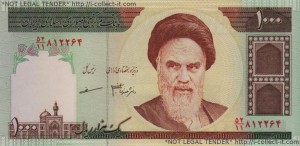 Iran is working to shrink and eventually eliminate the free market in its tumbling rial currency, the economy minister was quoted as saying amid signs that foreign exchange trade outside a government-sanctioned centre was drying up.
Iran is working to shrink and eventually eliminate the free market in its tumbling rial currency, the economy minister was quoted as saying amid signs that foreign exchange trade outside a government-sanctioned centre was drying up.
“The unofficial currency market will be gathered up,” Shamseddin Hosseini was quoted as saying by the Mehr news agency on Wednesday.
“The foreign exchange centre is being completed step by step, and its development will eventually lead to the elimination of the tricksters’ market.”
Hosseini was speaking after the rial plunged to a record low against the U.S. dollar on Tuesday, losing about a third of its value in a week and exposing President Mahmoud Ahmadinejad to accusations in parliament that he was not competent to manage the economy.
Western sanctions imposed over Iran’s controversial nuclear energy programme have slashed its export earnings from oil, giving the central bank less firepower to support its currency. Panicking Iranians have scrambled to buy hard currencies, pushing down the rial.
The rial hit a record low of around 37,500 to the dollar in the free market on Tuesday, from about 24,600 just eight days earlier, foreign exchange traders in Tehran said.
On Wednesday, Mehr reported the free-market rate had opened at 36,100. But traders in Tehran did not respond to telephone calls from Reuters and there were signs that they had halted business.
The website of SarafiJalali.com, a Tehran-based moneychanger, said: “To comply with the policies of the Central Bank of the Islamic Republic of Iran, and to help organise the currency market of Iran, Sarafi Jalali for now will not announce any rates. Subject to permission from the central bank, the announcement of a new rate will be made.” It did not elaborate.
A message on the website of Mazanex, which provides real-time rial prices, read: “Unfortunately access to this site and several similar sites has been closed.”
Several foreign exchange traders contacted by Reuters in Dubai, a major centre for business with Iran, said they were no longer quoting the rial because they had lost contact with their counterparts in Tehran.
The rial has been falling for over a year and has lost about two-thirds of its value since June 2011. In an effort to stabilise the currency, the government last week launched an “exchange centre” to supply dollars to importers of basic goods.
Initially at least, the effort failed; according to a central bank statement, the centre supplied only $181 million in its first week, not nearly enough to satisfy demand.
But Hosseini said on Wednesday that authorities would continue using the centre in order to replace the volatile free market, which the government says has been manipulated by speculators.
About $100 million per day is now traded on the government-backed centre, Hosseini said.
Reuters
Leave a Reply
You must be logged in to post a comment.